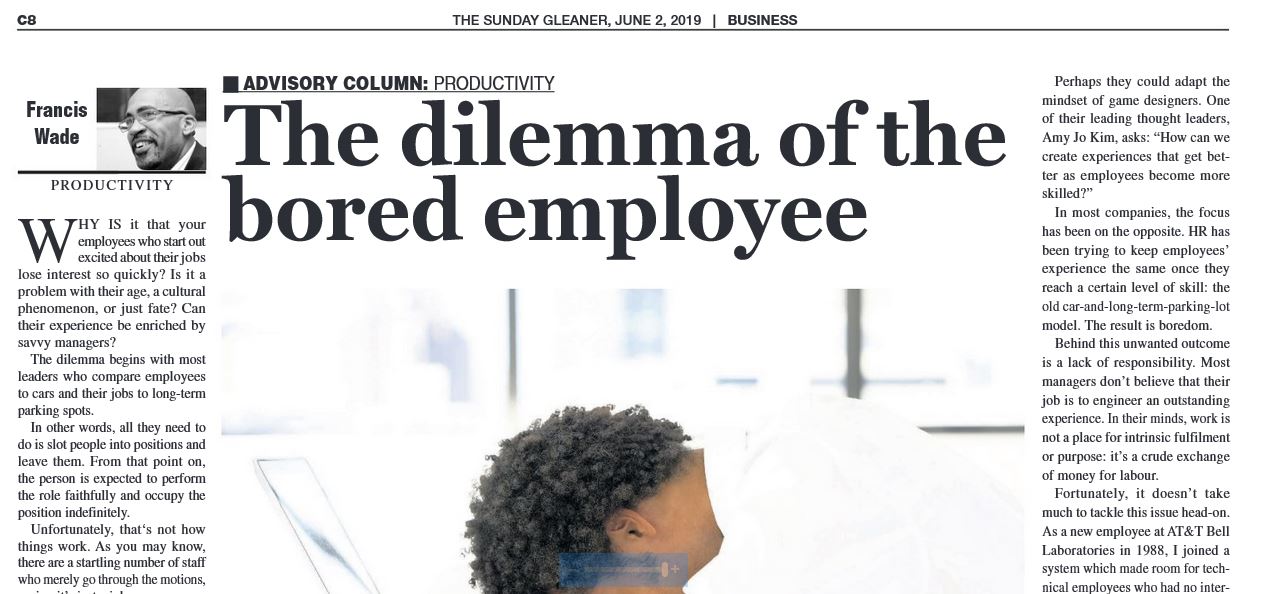Why is it that your employees who start out excited about their jobs lose interest so quickly? Is it a problem with their age, a cultural phenomena or just fate? Can their experience be enriched by savvy managers?
The dilemma begins with most leaders who compare employees to cars and their jobs to long-term parking spots. In other words, all they need to do is slot people into positions and leave them. From that point on, the person is expected to perform the role faithfully and occupy the position indefinitely.
Unfortunately, that‘s not how things work. As you may know, there are a startling number of staff who merely go through the motions: “It’s just a job.” Long gone are the challenges which kept them up at night. All that’s left is a routine they can now do without thinking.
Predictably, they turn their attention to other life demands. They raise children to pass exams with top grades. They sign up for marathons. They become deacons in their churches and volunteers in community organizations. While there’s a great deal of good they accomplish in all these other areas, their career remains stagnant: the same job from one day to the next. A few convince themselves that the steady salary is worth the deadening sacrifice. Others refuse. They walk away, quitting to find a different career or start their own company.
Meanwhile, executives in your firm probably remain clueless about the real depth of disengagement: the high percentage who give their work-life the bare minimum. Understanding why employees are more dissatisfied than ever can help you produce a breakthrough culture.
The New Employee
Today’s entering staff member is often surprised at the stale environment found inside most companies. The truth is, little has changed over the years. People at all levels are still stuck in the car-and-parking-spot frame of mind.
Why are they shocked? They have been raised in a world of high engagement in which social media, entertainment and games occupy a great deal of their personal energy. Each of these platforms is engineered to grab hold of a user’s attention and keep it for extended periods of time.
By comparison, most jobs in the workplace seem to be designed to lose, disrupt or even destroy attention. It’s tempting to think this has something to do with technology: instead, it’s all about intention.
Creators of highly engaged online environments realize they are in a competition with other experiences. With every bit and byte, they intend to keep users interested and use attention as a measure of success. The makers of Facebook, Twitter and Instagram don’t want you to slip away.
Unfortunately, there are probably few managers in your company who see their challenge in the same way. They fail to recognize that “experience design” is part of their job, instead pretending as if nothing has changed over the years.
The outcome? Employees who can hardly last 15 minutes alone or in a meeting without reflexively searching their smartphones for something better.
A New Challenge
Most of your fellow managers probably just shrug their shoulders, complaining. For them, the point of engaging staff is not to entertain them, but make them productive.
Perhaps they could adapt the mindset of game designers. One of their leading thought leaders, Amy Jo Kim, asks: “How can we create experiences that get better as employees become more skilled?”
In most companies, the focus has been the opposite. HR has been trying to keep employees’ experience the same once they reach a certain level of skill: the old car-and-long-term-parking-lot model. The result is boredom.
Behind this unwanted outcome is a lack of responsibility. Most manager’s don’t believe that their job is to engineer an outstanding experience. In their minds, work is not a place for intrinsic fulfillment or purpose: it’s a crude exchange of money for labour.
Fortunately, it doesn’t take much to tackle this issue head-on. As a new employee at AT&T Bell Laboratories in 1988, I joined a system which made room for technical employees who had no interest in becoming supervisors. A technical ladder allowed many to be promoted and recognized without having the burden of direct reporting relationships.
At a micro level, your company can train managers to develop detailed ladders of skills. Imagine if, at any moment in time, your employees could know exactly which rung they occupy. Furthermore, they would also be able to pinpoint which skills they are developing. This way, they know when their next personal improvement target happens to be.
This form of career gamification can engage even long-term staff, blocking the default – boredom – which thwarts your company’s goals.
http://jamaica-gleaner.com/article/business/20190602/francis-wade-dilemma-bored-employee

Chronicles from a Caribbean Cubicle
New Thinking from Framework Consulting
